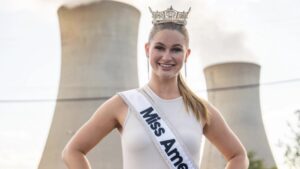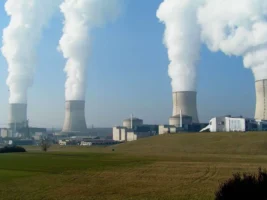“Jam tomorrow, jam yesterday, but never ever jam today!” So says the White Queen in Lewis Carroll’s Through the Looking Glass and What Alice Found There.” It’s entered the vernacular to describe a never-fulfilled promise. It turns out it’s also the federal Coalition’s energy policy.
Last Wednesday, on a single sheet of parchment, the Australian electorate was presented with a faint outline of the Coalition’s nuclear plans. There was precious little detail. A couple of reactors in this state, a couple in this one, and so on, all at sites hosting current or former coal fired power stations.
There were no costings. Just a lot of promises to stop renewables, and bulldoze any opposition from the states, the site owners and local communities, and to have the first nuclear operating by 2035, a timeline no one believes.
Over the weekend, there was nothing but confusion. Consider this exchange from Coalition energy spokesman Ted O’Brien and the ABC’s David Speers.
O’Brien: “Peter Dutton has made it clear. He’s more than happy for this election to be a referendum on cheaper, cleaner and consistent electricity.”
Speers: “And he said nuclear energy.”
O’Brien: “Nuclear is part of a balanced energy mix.”
Speers: “If you don’t win, that’s it?”
O’Brien: “Very happy to be public about that.”
Speers: “So if you don’t win, that’s it?”
O’Brien: “When it comes to, if we don’t win, firstly, we plan to win. And we are doing nuclear energy as part of that.”
Speers: “If you don’t win, you drop it?”
O’Brien: “It’s the right thing by this nation. There’s people like you who will run commentary on it.”
Speers: ‘I am asking if you accept the referendum.”
O’Brien: “I didn’t say it’s a referendum.”
Speers: “Peter Dutton said he’s very happy for this to be a referendum on energy and nuclear power.”
O’Brien: “You’re right. Because we want cheaper, cleaner and consistent …”
Over the weekend the Smart Energy Council released a quick analysis that put the cost of the Coalition energy plan between $118 billion and $600 billion, pointing to the series of massive over-runs of every single large scale nuclear power station that has begun construction in western economies in the last three decades.
But just park those numbers for a moment. The killer observation was that the Coalition nuclear plan would account for less than four per cent of the country’s electricity needs by around 2045. Less than four per cent.

This was highlighted by energy transition expert Simon Mason on LinkedIn. He put the nuclear rollout in the context of Australia’s energy needs over the next few decades – assuming that coal closes as planned.
The Coalition wants to stop renewables, so transmission lines don’t need to be built. Do you spot the gap? The Coalition, apparently, wants to fill it with the most expensive fuel currently available, fossil gas.
O’Brien was asked about this on the ABC. How much nuclear will be part of the energy grid under the Coalition plan? He channelled the White Queen, again.
“Firstly, I’m a Liberal. I appreciate and respect that investors want to make money. But to be really clear, our focus is on the Australian people who want to save money. And so we have designed this policy with a crystal clear vision of Australians paying for cheaper, cleaner …”
No real answer there. He did go on to say that it was the Coalition’s hope that to build “multi” nuclear units at the seven sites it has chosen across five states.
That, if it’s true, will require a significant expansion of transmission infrastructure to support that. None of the sites chosen are fitted out to deal with any units of the size contemplated by the Coalition – up to 1.4 GW – let alone “multiple” units.
And the fact is that those sites are owned by private companies, which are already in the process of filling up available transmission capacity with billions of dollars of investments in their own battery, hydro and hydrogen projects.
So, if the Coalition were – as National leader David Littleproud repeatedly demands – to stop the rollout of wind, solar, storage and transmission, and to rip up contracts for wind and solar written by the Commonwealth – then Australia is simply not going to have enough power.
But are they really going to stop renewables? O’Brien didn’t seem to know. He refused to answer any questions about the planned “mix” of technologies.
If it doesn’t stop renewables in their tracks, then they are still going to need all the transmission lines – 5,000kms not the 28,000 kms that the Coalition claims – that the nuclear plan is supposedly designed to avoid. But of course, that claim is bunkum anyway.
The Coalition is forging ahead despite the fact that big energy users, such as the aluminium smelters, say they don’t want nuclear. The utility industry says it is not interested. Bankers and insurers won’t touch it with a barge pole, because of the risks.
Former chief scientist Allan Finkel, an admirer of nuclear technology, says it would not be possible to get nuclear in Australia before the mid 2040s, even if we wanted to. He says a focus on nuclear rather than renewables makes climate targets impossible to meet.
This was a point taken up, with typical vigour, by former prime minister Paul Keating over the weekend.
“Dutton, like Abbott, will do everything he can to de-legitimise renewables and stand in the way of their use as the remedy nature has given us to underwrite our life on earth,” Keating wrote.
“By his blatant opposition to renewables, Dutton calls into question and deprecates all the government has done to provide Australian business with a reliable and dependable framework for investment in renewables.”
But what do we hear? Ziggy Switkowski, who just a few years ago said large scale nuclear had had its day, is now singing its praises.
But another ardent support of the flick to nuclear is Dr Adi Patterson, the former boss at ANSTO, who describes the CSIRO GenCost report as a “form of fascism” and compares the Australian Energy Market Operator to “Animal Farm”. He says large scale nuclear is not a good idea, and says he has been saying as much for more than two years.
“People are not listening,” he told Sky News. “I think we should be building reactors at the scale of a large wind turbine.”
Patterson suggested that 5 MW so called “micro” reactors being promoted by the likes of Bill Gates, Westinghouse and Rolls Royce could be spread right across the grid. “They could literally be built in our backyard,” Patterson told Sky News. “These are being built now,” he added. Which is actually not true – they are an idea, not yet a thing.
Consider this, though. Just to match the capacity of retiring coal fired power stations, for a start, would require around 4,000 of these nuclear micro reactors to be scattered across the country – in our backyards, as Patterson suggests – a bit like Labor’s community batteries rollout , but with nuclear in place of lithium ion.
What could possibly go wrong?
“I’m sure I’ll take you with pleasure!” the White Queen said. “Two pence a week, and jam every other day.”
From: Through the Looking Glass and What Alice Found There.
Alice couldn’t help laughing, as she said, “I don’t want you to hire me – and I don’t care for jam.”
“It’s very good jam,” said the Queen.
“Well, I don’t want any to-day, at any rate.”
“You couldn’t have it if you did want it,” the Queen said. “The rule is, jam to-morrow and jam yesterday – but never jam to-day.”
“It must come sometimes to ‘jam to-day’,” Alice objected.
“No, it can’t,” said the Queen. “It’s jam every other day: to-day isn’t any other day, you know.”
“I don’t understand you,” said Alice. “It’s dreadfully confusing!”










